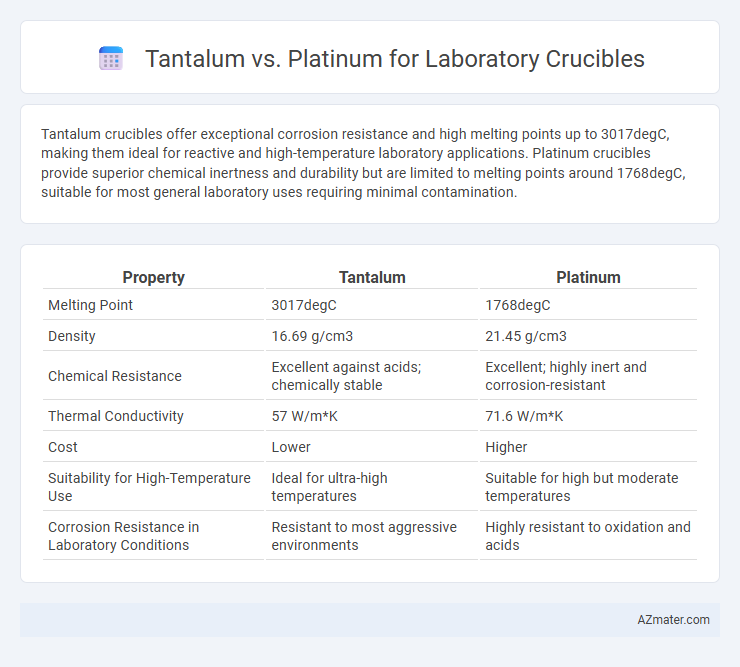Tantalum crucibles offer exceptional corrosion resistance and high melting points up to 3017degC, making them ideal for reactive and high-temperature laboratory applications. Platinum crucibles provide superior chemical inertness and durability but are limited to melting points around 1768degC, suitable for most general laboratory uses requiring minimal contamination.
Table of Comparison
| Property | Tantalum | Platinum |
|---|---|---|
| Melting Point | 3017degC | 1768degC |
| Density | 16.69 g/cm3 | 21.45 g/cm3 |
| Chemical Resistance | Excellent against acids; chemically stable | Excellent; highly inert and corrosion-resistant |
| Thermal Conductivity | 57 W/m*K | 71.6 W/m*K |
| Cost | Lower | Higher |
| Suitability for High-Temperature Use | Ideal for ultra-high temperatures | Suitable for high but moderate temperatures |
| Corrosion Resistance in Laboratory Conditions | Resistant to most aggressive environments | Highly resistant to oxidation and acids |
Introduction to Laboratory Crucibles
Laboratory crucibles are essential containers used for high-temperature chemical reactions and melting substances, requiring materials with exceptional thermal stability and resistance to corrosion. Tantalum crucibles offer superior resistance to thermal shock and chemical attack, making them suitable for reactive and high-purity environments, while platinum crucibles provide excellent durability and stability at extremely high temperatures with superior oxidation resistance. The choice between tantalum and platinum depends on specific experimental needs such as temperature range, chemical compatibility, and contamination tolerance in laboratory applications.
Overview of Tantalum and Platinum as Crucible Materials
Tantalum and platinum each offer unique advantages as laboratory crucible materials, with tantalum prized for its high melting point (3017degC), excellent corrosion resistance, and ability to withstand extreme temperatures in inert or reducing atmospheres. Platinum, with a melting point of 1768degC, excels in high-temperature applications requiring superb chemical inertness and resistance to oxidation, making it ideal for processes involving aggressive acids or oxidizing environments. Both metals provide exceptional durability and chemical stability, but tantalum is favored for ultra-high temperature conditions, while platinum is preferred for applications demanding superior corrosion resistance and purity.
Physical and Chemical Properties Comparison
Tantalum exhibits a melting point of approximately 3017degC and exceptional resistance to chemical corrosion, making it highly suitable for crucibles exposed to aggressive chemicals and high temperatures. Platinum, with a melting point near 1768degC, offers excellent thermal conductivity and superior resistance to oxidation but is less resistant to some molten acids compared to tantalum. The choice between tantalum and platinum crucibles depends on the specific laboratory application, balancing melting point requirements and chemical resistance in corrosive environments.
Thermal Stability and Melting Points
Tantalum crucibles exhibit exceptional thermal stability with a melting point of approximately 2996degC, making them suitable for high-temperature laboratory applications requiring resistance to oxidation and chemical corrosion. Platinum crucibles, with a melting point of about 1768degC, offer excellent resistance to chemical attack and thermal cycling but are less stable at extremely high temperatures compared to tantalum. The superior melting point and robust thermal stability of tantalum make it the preferred choice for processes exceeding platinum's thermal limits.
Chemical Resistance: Acid and Alkali Environments
Tantalum crucibles exhibit exceptional chemical resistance to a broad spectrum of acids, including hydrochloric, sulfuric, and nitric acids, making them ideal for handling highly corrosive acid environments. Platinum crucibles also demonstrate superior corrosion resistance but are particularly renowned for their stability in oxidizing acids and resistance to alkali attacks, including strong bases like sodium hydroxide. Both metals maintain structural integrity in acid and alkali environments, but tantalum offers enhanced durability in aggressive acidic conditions, whereas platinum is preferred for mixed or alkaline solutions requiring high-temperature applications.
Cost and Availability Analysis
Tantalum crucibles offer a cost-effective alternative to platinum with significantly lower material expenses, making them suitable for high-temperature laboratory applications on a budget. Platinum, prized for its exceptional chemical inertness and high melting point, commands a premium price and often faces supply limitations due to mining constraints. Availability of tantalum is generally higher in industrial markets, while platinum's rarity can result in longer lead times and increased procurement costs for laboratory use.
Mechanical Strength and Durability
Tantalum crucibles exhibit superior mechanical strength and excellent resistance to thermal shock, making them highly durable under extreme laboratory conditions. Platinum crucibles offer high corrosion resistance and maintain structural integrity at elevated temperatures but are softer and more prone to deformation than tantalum. For applications requiring robust mechanical durability and prolonged lifespan, tantalum often outperforms platinum despite its higher reactivity in certain chemical environments.
Typical Applications in Laboratory Settings
Tantalum crucibles are preferred in laboratory settings for high-temperature applications involving reactive or corrosive materials due to their excellent resistance to oxidation and chemical attack. Platinum crucibles, prized for their exceptional thermal stability and inertness, are commonly used in analytical chemistry, especially for melting, weighing, and heating small quantities of samples without contamination. Both materials support precise temperature control but tantalum excels in reducing contamination in aggressive environments, while platinum offers superior durability for repeated heating cycles.
Maintenance and Longevity Factors
Tantalum crucibles exhibit superior resistance to chemical corrosion and high-temperature oxidation compared to platinum, resulting in reduced maintenance frequency and longer service life in aggressive laboratory environments. Platinum crucibles offer excellent thermal conductivity and inertness but require more frequent polishing to prevent surface contamination and degradation over time. The inherent durability of tantalum under extreme conditions often translates to lower overall maintenance costs and extended operational lifespan for laboratory crucibles.
Summary: Choosing Between Tantalum and Platinum Crucibles
Tantalum and platinum crucibles each offer distinct advantages for laboratory use, with tantalum excelling in resistance to high-temperature corrosion and cost-effectiveness, while platinum provides superior chemical inertness and thermal stability. Platinum crucibles are preferred for processes requiring extreme purity and resistance to aggressive chemicals, whereas tantalum crucibles are suitable for less corrosive environments with high melting points. Selecting between these materials depends on specific experimental conditions such as temperature range, chemical compatibility, and budget constraints.

Infographic: Tantalum vs Platinum for Laboratory crucible
 azmater.com
azmater.com